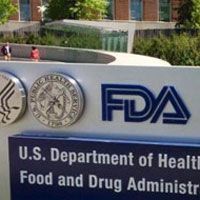Dabrafenib/Trametinib Combination Approved for BRAF+ NSCLC
The FDA has approved the dabrafenib/trametinib combination for patients with BRAF V600-positive advanced or metastatic non-small cell lung cancer (NSCLC)
Dabrafenib/Trametinib Combination Approved for BRAF+ NSCLC

The FDA approved the combination of dabrafenib (Tafinlar) and trametinib (Mekinist) for patients with BRAF V600—positive advanced or metastatic non–small cell lung cancer (NSCLC).
The agency gave the combination breakthrough designation for patients with BRAF V600E­—mutant NSCLC, which has been associated with poorer prognosis, in 2015. The European Union approved the dabrafenib/trametinib combination in April.
The FDA also approved the Oncomine Dx Target Test, a next generation sequencing (NGS) test, which detects the presence of BRAF, ROS1, and EGFR gene mutations. According to the agency, this is the first NGS oncology panel test it has approved for multiple companion diagnostic indications.
“Patients with BRAF V600E mutation­—positive metastatic NSCLC have responded less favorably to standard chemotherapy, suggesting that there is a critical need for a targeted therapy,” Bruno Strigini, CEO, Novartis Oncology, said in a press release.
"The approval of Tafinlar plus Mekinist makes BRAF V600E the fourth actionable genomic biomarker in metastatic NSCLC—along with EGFR, ALK and ROS-1,” said Bruce Johnson, MD, lead study author and chief clinical research officer, Dana-Farber Cancer Institute and Harvard Medical School at Dana-Farber Cancer Institute. “This is an important milestone for the lung cancer community, as we are continuing to better understand the genomic drivers of cancer and develop effective treatments targeted for these biomarkers.”
That approval was based on results from a 3-cohort, multicenter, nonrandomized, open-label study of patients with stage IV NSCLC.
In this phase II study, 36 treatment-naïve patients and 57 previously-treated patients were assigned to 150 mg twice daily of dabrafenib and 2 mg once daily of trametinib. Investigator-assessed objective response rate (ORR) was the primary endpoint. Previously treated patients had undergone at least 1 prior line of platinum-based chemotherapy, and one-third underwent at least 2 prior treatment cycles.
At a median follow-up of 9 months, the ORR was 61.1% (95% CI, 43.5-76.9) in the treatment-naïve group, and 68% of patients did not show progression. The group had not reached endpoints for median duration of response (DOR) or progression-free survival (PFS) at the time of approval. However, among patients who responded to treatment, 59% had responses lasting longer than 6 months.
The ORR was 63% (95% CI, 49-76) in the previously treated population. Researchers found that the response was durable, with a median DOR of 12.6 months (95% CI, 6.9-16.0).
These data for the previously treated arm are updated from results reported at the 2016 ASCO Annual Meeting and published in The Lancet Oncology.1,2 The earlier findings showed an ORR with the combination of 63.2% (95% CI, 49.3-75.6), which lasted for a median duration of 9.0 months (95% CI, 6.9-18.3). The overall disease control rate was 79% (95% CI, 66-89) when patients who had stable disease for ≥12 weeks were included. Median PFS was 9.7 months (95% CI, 6.9-19.6).
After a median follow-up of 11.6 months, 2 patients (4%) assigned to the combination experienced a complete response, in the earlier findings. Overall, 9 patients had stable disease as their best response (16%). Half of confirmed responses remained ongoing at the October 2015 data cutoff.
In the third arm of the phase II trial, 78 previously treated patients with metastatic BRAF V600E—mutant NSCLC received single-agent dabrafenib. The ORR in this cohort was 27% (95% CI, 18-38) and the median PFS was 5.5 months. Median DOR was 9.9 months.
The FDA reported that the most common all-grade adverse events (>20%) across the study included pyrexia, fatigue, nausea, vomiting, diarrhea, dry skin, decreased appetite, edema, rash, chills, hemorrhage, cough, and dyspnea. The most common Grade 3/4 adverse reactions were pyrexia, fatigue, dyspnea, vomiting, rash, hemorrhage, and diarrhea.
The most common (≥5%) grade 3/4 laboratory abnormalities were hyponatremia, lymphopenia, anemia, hyperglycemia, neutropenia, leukopenia, hypophosphatemia, and increased alanine aminotransferase. Most laboratory abnormalities were grade 1/2.
The FDA first approved the combination of dabrafenib and trametinib for patients with metastatic melanoma in January 2014. The EU approved the dabrafenib/trametinib combination for adults with unresectable or metastatic melanoma with a BRAF V600 mutation a year later.
Dabrafenib and trametinib target BRAF and MEK1/2, respectively, 2 different kinases within the serine/threonine kinase family in the RAS/RAF/MEK/ERK pathway. The pathway plays a role in the development of multiple cancers, including NSCLC and melanoma.
Worldwide, there are roughly 1.8 million new cases of NSCLC diagnosed every year. About 36,000 patients, 1% to 3% of the total, are positive for the BRAF V600 mutation.
- Planchard D, Besse B, Groen HJM, et al. An open-label phase II trial of dabrafenib (D) in combination with trametinib (T) in patients (pts) with previously treated BRAF V600E—mutant advanced non-small cell lung cancer (NSCLC; BRF113928). J Clin Oncol. 2016;34 (suppl; abstr 107).
- Dabrafenib plus trametinib in patients with previously treated BRAFV600E-mutant metastatic non-small cell lung cancer: an open-label, multicentre phase 2 trial [published online June 6, 2016]. Lancet Oncol. DOI: 10.1016/S1470-2045(16)30146-2.



